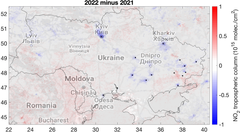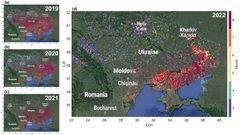Satellites capture socioeconomic disruptions during the 2022 full-scale war in Ukraine
Satellite observations show significantly reduced air pollution levels over the major Ukrainian cities, power plants and industrial areas.
Since February 2022, the full-scale war in Ukraine has been strongly affecting society and economy in Ukraine. Satellite observations provide crucial information to objectively monitor and assess the impacts of the war.
A new paper published today on Scientific Reports utilizes satellite observations of air pollutants and other relevant parameters from multiple platforms to assess the impacts of the ongoing war on the Ukrainian society. Satellite observations show that the concentrations of nitrogen dioxide (NO2), which is emitted through fossil fuel combustion processes, declined in 2022 over the major Ukrainian cities, power plants and industrial areas by 15–46%.
Such reductions reflect the decrease in population and corresponding emissions from the transport and commercial or residential sectors as well as the decline in industrial production, especially from the metallurgic and chemical industry, which led to a reduction in power demand and corresponding electricity production from power plants. Carbon dioxide (CO2) observations also indicate reductions in fossil fuel combustion, especially in eastern Ukraine, where the largest emission sources are located.
“During peaceful times, reductions in nitrogen dioxide concentrations as those observed here would be considered as a welcome improvement of air quality and human health. In this case, the observed changes tell a different story about the extent of the disruption caused by the war on the Ukrainian society and economy. Also, the reductions in fossil fuel consumption in Ukraine might have been partly offset by an increase elsewhere”, explains senior researcher at the Finnish Meteorological Institute Iolanda Ialongo, who led the work.
Exceptional fire patterns near the front line
Satellite imagery and fire detections indicate an anomalous distribution of fires along the front line, which are attributable to shelling or other war-related fires, rather than the typical homogeneously distributed fires related to crop harvesting. Satellite imagery data also show drastic changes over the city of Mariupol, which was attacked during the first three months of the war.
The signal from the hot smokes from the metallurgic industrial facilities in the city disappears from the satellite imagery after March 2022, which suggest an interruption of industrial activities, and, correspondingly, NO2 levels decreased.
The results are based on the NO2 retrievals from the European TROPOMI (TROPOspheric Monitoring Instrument), onboard the Sentinel 5 Precursor satellite, and the CO2 observations from the NASA’s OCO-2 satellite. Also satellite imagery from the Sentinel 2 satellite was analyzed as well as fire detections from the Visible Infrared Imaging Radiometer Suite (VIIRS).
The research was carried on at the Finnish Meteorological Institute together with colleagues from the University of Lviv (Ukraine) and USRA (USA). The Finnish part of the research was supported by the Ministry for Foreign Affairs of Finland via the Interinstitutional Development Cooperation Instrument (ICI), UHMC-FMI Meteorology project and the Research Council of Finland.
Keywords
Contacts
Senior researcher Iolanda Ialongo, Finnish Meteorological Institute, iolanda.ialongo@fmi.fi
Images


Links
Alternative languages
Subscribe to releases from Ilmatieteen laitos
Subscribe to all the latest releases from Ilmatieteen laitos by registering your e-mail address below. You can unsubscribe at any time.
Latest releases from Ilmatieteen laitos
Viikonlopulle tiedossa aurinkoa, pakkasta ja lumisateita11.12.2025 13:45:34 EET | Tiedote
Sää kylmenee loppuviikoksi, mutta lauhtuu jälleen ensi viikon alussa. Maa muuttuu monin paikoin valkeaksi etelässäkin lumisateiden myötä.
Marraskuu oli maailmanlaajuisesti mittaushistorian kolmanneksi lämpimin9.12.2025 05:00:00 EET | Tiedote
Copernicus-ilmastopalvelun mukaan marraskuu 2025 oli maailmanlaajuisesti mittaushistorian kolmanneksi lämpimin. Vuodesta 2025 näyttää muodostuvan mittaushistorian toiseksi tai kolmanneksi lämpimin.
Itsenäisyyspäivää vietetään pilvisessä säässä4.12.2025 12:15:46 EET | Tiedote
Maan etelä- ja keskiosassa on odotettavissa vesi- ja räntäsadetta. Lämpötila on enimmäkseen nollan tuntumassa tai sen yläpuolella, Lapissa on pakkasta.
Uudet karttatyökalut tarjoavat tarkkaa tietoa ilmastonmuutoksesta ja kaupunkien pienilmastosta3.12.2025 14:00:00 EET | Tiedote
Miten ilmastonmuutos etenee maakunnittain seuraavien vuosikymmenten aikana? Missä suomalaiskaupungeissa syntyy kuumia lämpösaarekkeita jo nyt? Muun muassa näihin kysymyksiin löytyy tietoa uusista karttatyökaluista, jotka ovat maksutta kaikkien käytettävissä.
Syksy oli osassa maata poikkeuksellisen lämmin1.12.2025 11:41:27 EET | Tiedote
Syksy oli mittaushistorian toiseksi lämpimin useilla Ilmatieteen laitoksen havaintoasemilla. Marraskuussa Suomi jakautui sään osalta kahteen: Lapissa oli kylmää, muualla maassa lauhaa.
In our pressroom you can read all our latest releases, find our press contacts, images, documents and other relevant information about us.
Visit our pressroom